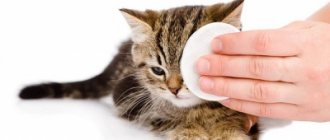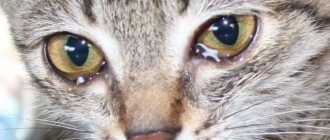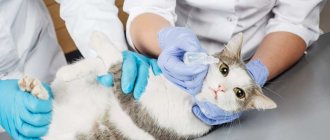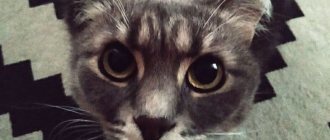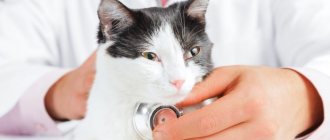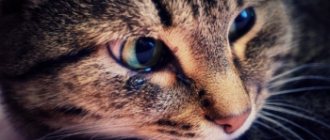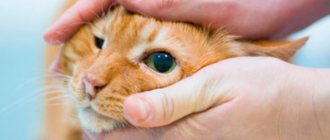Maria Alexandrovna Sazhko
veterinary therapist
Veterinarians are often asked to tell us how to wash the eyes of kittens and adult animals, so we decided to prepare a whole article on this topic.
Normally, a healthy cat or cat follows the rules of hygiene on its own, caring for the hair of the entire body, face and tail. Unfortunately, the animal is not always able to independently remove all contaminants from the eyes, skin and fur around it; in this case, the intervention of the owner is required.
It is important to always pay attention to the appearance and general condition of the pet and, if necessary, if you notice an unkempt appearance, extensive dirt or pain, immediately seek help from a doctor.
When is eye rinsing necessary?
This manipulation is necessary in a number of cases: prevention of secondary infection in case of injury, routine treatment of a contaminated eye in an animal predisposed to contamination, when removing mechanical contaminants and drug residues during treatment of an eye or systemic infection. Let's consider this issue in more detail.
Eye diseases
Conjunctivitis
– inflammation of the mucous membrane of the eye, that is, the conjunctiva, caused by a viral or bacterial infection, allergic reaction, injury, etc. Manifested by swelling of the conjunctiva, redness, active discharge and soreness.
Blepharitis
– an eye disease that affects a cat's eyelids. The eyes look swollen, discharge accumulates around them and dries into crusts, and there is itching and restlessness on the part of the animal.
Glaucoma
– this is a disease that develops as a result of increased intraocular pressure, manifested by damage to the optic nerve and retina. The chronic course of the disease can cause optic nerve atrophy, that is, lifelong blindness. The main manifestations are an increase in the volume of the eyeball, clouding, lacrimation, redness, etc.
Keratitis
– disease of the cornea of the eye. This pathology can be caused either by injury or be secondary to another eye disease. It manifests itself as swelling, lacrimation, clouding of the cornea, and when complicated by a secondary infection – itching and pain.
Cataract
– a rare disease, typical mainly for older animals, which consists of clouding of the lens of the eye. This change can be caused by chronic diseases of the animal - diabetes, trauma, intoxication, metabolic disorders, genetic predisposition, etc. Visually, this condition is noticeable only in the later stages.
Turn of the century
- A fairly rare disease in cats. This is a congenital problem or acquired as a result of long-term inflammatory processes, which is manifested by improper placement of the eyelid and eyelash margin. Most often, it turns inward, thereby constantly injuring the surface of the eye. Visually, this pathology manifests itself very characteristically, but the first thing that owners most often pay attention to is redness, increased discharge from the eyes, and anxiety.
More details about each disease can be found in the article.
Injuries
Mechanical damage to the surface of the eye most often occurs in cats that are on their own or live in contact with other animals. Injuries are caused as a result of mutilation by sharp objects, in fights, falls and other unforeseen situations.
This pathology is manifested by general inflammatory signs - discharge from the eye, swelling, anxiety on the part of the pet, pain. As a result, on the surface of the eye you can see swelling of the corneal tissue - a whitish surface. At the appointment, a doctor who suspects an eye injury conducts a fluorescein staining test. Thus, he details the extent and depth of the lesion - prognosis and further therapy depend on this.
Each disease is unique in its own way and requires an individual approach and prescription. But one thing remains common in treatment - in case of any inflammation, it is necessary to rinse the cat’s eyes and keep them clean. Before any manipulations, administration of drugs - drops or ointments, the owner must thoroughly treat the eye from mechanical impurities and secondary bacterial infections. In advanced diseases, the cat’s eyes have to be washed even to remove pus.
Anatomical features
Some cats have anatomical features of the nasolacrimal duct. For example, narrow, short, folded eye orbits, like exophthalmos, skin folds, occur in short-faced cats - Persians, exotics, Scottish folds. Owners of these cats often experience excessive tearing and tear tracks. Under the eyes of such cats, the secretion of the lacrimal gland often accumulates, in which, over time, harmful bacteria develop, causing a local inflammatory process, alopecia, itching and anxiety on the part of the animal.
It is important for such breeds to pay timely attention, treat and wash their eyes, ensure the prevention of bacterial inflammation, clean the skin and fur around them, without waiting for secondary changes.
How and with what to wipe the eyes of cats for various diseases
Caring for a healthy adult cat usually does not require any attention to the eyes other than eye examination and occasional removal of accumulated secretions. But when treating infectious diseases and traumatic injuries, you need to know exactly what you can use to wash your pet’s eyes.
When it comes to kittens, the owner must be especially attentive and careful in his choice. You can wipe his eyes only with soft cotton sponges and safe solutions.
Chemistry against panic
In cases where a pet has encountered chemicals, it is important to find out what exactly it was stained with. And then choose what to wash the kitten’s eyes with:
- Before rinsing your eye, make sure that the solution you choose does not react violently with the chemical agent;
IMPORTANT! Trying to immediately neutralize a substance is dangerous. The reaction can be violent and can further damage vision. For a short time after the chemical gets into the eye, it will be contained by the mucous membrane.
- First, rinse your eyes with water; A warm (about 35 degrees) shower or water fountain for rinsing should be “soft”;
- After washing, it will be necessary to neutralize the remaining aggressive substance. Let someone help you save time while you prepare the neutralizing solution.
- It takes 10-15 minutes to rinse the cat's eyes from chemicals with clean running water. The eyelids should be wide open (you will have to help the animal, even if it resists).
ADVICE! Almost all synthetic cleaners and detergents are slightly acidic, while natural soaps are alkaline.
Acids
After a water shower, continue to rinse with a 2% sodium bicarbonate solution (can be purchased at a pharmacy). If the pain bothers your pet too much, instilling a drop of novocaine solution (1%, for the eyes) is acceptable.
Alkalis
Alkali is quite difficult to remove from the mucous membrane. After a ten-minute rinse with water, at least half an hour of neutralization with isotonic sodium chloride (saline solution for injection) will be required. And then a 1% aqueous solution of ascorbic acid will not be amiss.
Recommendations
Very often on the Internet and in books you can find a recommendation: for prevention, wipe the eyes of pets with a solution of boric acid. The trouble is that pharmacies, upon request, often sell an alcohol preparation, which not only will not improve your pet’s vision, but can also seriously harm it. And not all sources indicate that what is needed is an “aqueous solution of boric acid”! It’s better to use plain boiled water than to wash your cat’s eyes with boric acid and alcohol!
ADVICE! Carefully read, double-check and wisely apply any recommendations for caring for animals yourself!
Kittens' eyes appear large and wide open. This is a quirk of nature - the size of the eyeball does not change much throughout life. Babies are born with eyes almost like those of an adult animal. Hence, there is a high probability of injury and initiation of any parts of the eye.
In order not to harm your pet even more, be careful and try to wash your kitten’s eyes only in cases of real need: injuries, severe contamination, suspected infection, or when treating already identified diseases.
Veterinary care for eye injuries and diseases
For each case, veterinary medicine has developed a separate algorithm of actions. Depending on the severity of the damage, you can use clean water (for example, buy sterile water for injection), antiseptics, and antibiotics. Before rinsing your kitten's eyes, consult your veterinarian's handbook.
ADVICE! Each pet is unique. If one owner is proud: “I clean my cat’s eyes with tea every day,” this does not mean that this method will suit your pet. Better consult your veterinarian.
Injury to the century
Please note that we are not talking about the mucous membrane of the eye or the cornea, but only about the soft tissues of the eyelid. If the wound is small and located at a sufficient distance from the mucous membrane, then the algorithm of actions is as follows:
- Wipe blood-stained fur with a sponge moistened with boiled water or water for injection. You can also use a sterile prophylactic eye lotion. Often this is enough for kittens who are playing;
- If the wound is more serious, it can be treated with a 1% solution of brilliant green (green) using a cotton swab. Make sure that the solution (it’s alcohol-based!) does not get on the mucous membranes on the wet fur;
- When the wound is serious, it is better to consult a doctor. The veterinarian will likely supplement the treatment regimen with local anesthesia and, if necessary, stitches.
NOTE! In most cases, “rinsing a kitten's eyes” means wiping them with a well-moistened sponge. Rinsing with a stream of solution or water is only necessary in case of chemical and mechanical damage: dust, powders, strong solutions.
Blepharitis, or inflammation of the eyelids
If the edge of the eyelid thickens and turns red, and scales and even ulcers appear at the base of the eyelashes, the kitten most likely has blepharitis. This is a fairly rare occurrence, but it must be treated, otherwise constant lacrimation will create the preconditions for a secondary infection. How to treat a kitten's eyes in this case:
- The edge of the eyelid, without touching the mucous membrane, must be degreased with alcohol-ether in a 1:1 ratio. In its absence, good old brilliant green will help - it dries and relieves inflammation;
- An ointment is placed under the eyelid (conjunctival sac). In veterinary medicine, synthomycin (1%), ointment, gentamicin emulsion is used;
- If inflammation of the eyelid is caused by demodex (mite), then treatment for the parasite is mandatory and primary!
Conjunctivitis
One of the fairly common diseases that occurs both on its own and as part of complex infections, for example, with calcevirosis and rhinotracheitis. In the complex treatment of infections, the doctor must prescribe what to wipe the kitten’s eyes with. But the cause of the disease can be even a banal vitamin deficiency or contact with aggressive chemicals. In any case, the principle of treating conjunctivitis does not change:
- The first thing you need to do is wash the kitten’s eyes from suppuration and crusts - with a special lotion or clean water. Then the skin and fur should be blotted with a dry towel;
- Astringent drops are used: protargol (1-2%), sulfazinc (1-2%), hydrocortisone;
- Purulent conjunctivitis requires the use of antibiotics - penicillins, tetracyclines in the form of ointments, albucid (30%);
- Conjunctivitis is a case where doing nothing or wiping your eyes with tea is much worse than washing your cat’s eyes with furatsilin or a 3% aqueous solution of boric acid.
WASHING TECHNIQUES . Draw at least 10 ml of solution into a syringe without a needle. Place the cat on your lap with its back to you. You need to direct the solution slowly, from the outer corner of the eye to the inner. It is important to clean the conjunctival sac as thoroughly as possible. Place a towel or cotton swab at the inner corner of the eye (with your other hand) to collect the solution containing purulent discharge. After the procedure, wipe and dry your pet's face.
- Good results are obtained by using conservative regimens: for example, Sofradex drops. The eyes need to be cleaned first.
Keratitis, or inflammation of the cornea
The inflamed cornea of the eye temporarily becomes cloudy. To neutralize the symptoms and prevent the formation of a cataract, hydrocortisone ointment (placed behind the eyelid in a thin “sausage”), antibiotics and sulfonamides are used. Before administering the medicine, be sure to rinse the cat’s eyes with an aqueous solution: boric acid, furatsilin, fugarin.
For cataracts, treatment is usually carried out using eye drops (Katachrome, Taufon). You can rinse your eyes with saline until the drops are gone.
Do not use cleaning wipes soaked in solutions unless recommended by a veterinarian. Tannins in plant infusions and decoctions can also react with medications, so before you rub tea on your kitten's eyes, ask your doctor if it will harm you.
Remove sharp objects, household appliances, cleaning products and medications away from your pet. And equip the veterinary first aid kit with ophthalmological first aid: a sterile solution of furatsilin, water for injection, saline solution, brilliant green, tetracycline, hydrocortisone in ointments and therapeutic and prophylactic eye drops (Anandin).
How to wash the eyes of kittens and adult cats?
Folk remedies
To wash the eyes of a cat or kitten, you can use diluted infusions of tea or herbs. It is important to use solutions at a comfortable temperature that does not injure or burn.
The following options can be used:
- Strong tea or tea leaves.
To do this, you will need to brew strong tea/decoction and let it sit for 10–12 hours, or better yet, a day. It is important to use loose leaf tea or herbs, and not tea bags.
- Chamomile decoction.
One brewed bag of chamomile at room temperature is enough. It must be remembered that it can dry out the skin with frequent use.
- St. John's wort decoction.
This decoction must be used diluted.
- Calendula decoction.
An aqueous decoction made from calendula flowers. It is important to dilute it before using it for eye treatment.
Pharmacy products
You can use standard, readily available drugs from a humanitarian pharmacy.
- Sodium chloride solution 0.9%.
Standard saline solution used for intravenous administration. When used, it can be drawn up sterilely using a syringe. This way the remaining bottle will remain sterile and suitable for further use.
- Aqueous solution of chlorhexidine 0.01%.
It is important to pay attention to the concentration of the drug and the absence or presence of alcohol-containing substances in it.
- Furacillin solution 0.02%.
Also use low concentration.
Specialized means
A cat’s eyes can be washed at home with any of the following means, both as a preventive measure and in combination with medicinal drugs to treat any disease:
- "Diamond Eyes"
– a drug with chlorhexidine, taurine and chlorocide C. These cat eye drops are an antiseptic that can be used as a prophylaxis and, as a concomitant remedy, in the treatment of ophthalmic pathology.
- Eye cleaning lotion from any brand.
It is important to pay attention to the principle of use of the drug, prescribed in the instructions - usually they cannot be used against “tear paths” and in no case applied to the surface of the eye.
Hurry up, choose a box and find out what gift awaits you
Discount on pet insurance
Promo code copied to clipboard
Causes of discharge from a cat's eye
Eye problems can have devastating consequences. Therefore, as a cat owner, you should be aware that your cat has eye problems. Here are a few reasons why your cat may have eye problems:
- Respiratory infections : A common cause of eye discharge in cats can be infectious respiratory disease, pneumonitis or rhinotracheitis, feline calicivirus (FCV) and protozoa. Early signs of such infections can be very mild or very serious, such as sticky, pus-filled discharge.
- Corneal diseases : A cat's cornea is a dome-shaped surface covering the front of the eye. It can easily become inflamed, injured, or ulcerated. If you see your cat blinking excessively or having excessive tear production, your cat most likely has a corneal disease.
- Conjunctivitis : Note that if there is light pink mucous membrane around your cat's eyes that is swollen, your cat may develop a watery or thick mucous discharge from the eyes. This is not a very common sign, but conjunctivitis with fever, diarrhea and breathing problems can be a serious infection in cats.
- Dry eyes : A dry eye condition is a lack of watering in your cat's eyes. It can lead to inflammation of the cornea and red eyes, and if left untreated, it can lead to blindness. Since the eyes do not produce water, a sticky yellow discharge from the eyes may follow.
© shutterstock
How to wash the eyes of an adult cat?
As auxiliary means for eye treatment, you may need:
- a pipette or syringe without a needle for applying the drug to the surface of the eye;
- a cotton pad or gauze swab (or sterile rags) - to remove dirt and excess drug;
- a blanket - as a means of humane fixation if the cat has a negative attitude towards this procedure;
- treats as positive reinforcement - encouragement.
The main thing when washing your eyes:
- Calm
It is important to approach this manipulation calmly and carefully. Under no circumstances should you grab a cat and force it to cooperate with a rough fixation - in this way you can scare it forever, and the cat will greet each procedure like a wild animal.
- Humane fixation
It's easy to pick up a calm and loving cat. But what to do with an aggressive or touch-intolerant pet? This is where a blanket with a homely scent will come to the rescue. With caring movements, you need to wrap the cat in a blanket, thereby immobilizing it and giving it a feeling of security.
- Speech
It is important to continue talking to the cat throughout the entire procedure in a calm and quiet voice, even if the cat begins to be indignant. Your speech will make it clear to the tailed one that everything is fine and nothing threatens him.
- It is necessary to drop 2-3 drops of the solution we have chosen into each eye and let the animal blink several times. This will remove excess solution through the outer corners of the eyes, as if he were crying.
- Using a rag or napkin soaked in the selected solution, you need to remove excess and dirt accumulated around the eyes. Cleanse the coat and skin with gentle massaging movements. Do not injure your eyes under any circumstances. It is important to use a separate tissue for each eye.
If necessary, the prescribed drops can be dropped into the cat's already cleaned eyes again.
General recommendations for eye drops
It is quite possible that the kitten will not be delighted with this event. The main thing is to do everything quickly and confidently:
- Before you start washing your kittens' eyes, be sure to thoroughly wash your hands with soap.
- It is more convenient to do the washing together. You can ask someone to hold your pet while lying on its back; it is better to do this on your knees. You need to be careful, since an adult cat can do nothing but hit with strong paws, and at this time the pet’s eyeball may be damaged.
- It is necessary to turn the animal so that the head is higher than the body.
- It is allowed to use a solution at room temperature, the maximum temperature is 37 degrees. If the temperature is higher, the animal will get a burn to the eyeball.
- The pipette or bottle with drops should be located a centimeter above the surface of the eyes. If you don’t have a pipette at home, you can replace it with a disposable syringe. The needle must first be removed from the syringe.
- It is necessary to moisten a cotton swab in the desired solution, then, if the eyelids are stuck together, the solution must first be squeezed onto the eyelids, and then, after opening the eyelids, onto the eyes.
- If the eyelashes are stuck together, use a swab dipped in the solution to carefully walk along the outer part of the eyes. The direction of movements is from the nose to the corners. It is necessary to carry out these movements until the eyes begin to open.
- Afterwards, the skin around the eyelid is dried with a cotton swab.
- Do not touch the surface of your eyes with a dry cotton swab because the dry cloth will remove the top layer of skin cells.
- Do not touch the surface of the eyeball.
- After the solution is dripped into the eyeball, you need to bring the eyelids together. This is necessary so that the medicine is evenly distributed.
You should not use cotton wool, as its fibers will get on the eyeball and cause even more irritation.
If the eye ointment is preheated, it will be much easier to put into the eye.
How to wash kittens' eyes?
Eye treatment for kittens is very similar to that for adult animals. The basic principle is a humane approach and gentle procedure with the aim of cleansing, but not causing further injury. For comfortable fixation, a blanket and warmth are also used; soft fixation is possible at the skin fold of the withers as an imitation of a mother cat. You should not hold the kitten suspended by the skin fold, thereby causing pain. If an adult kitten is unnerved by this approach, stop immediately.
It is enough to apply 1 drop of solution to each eye. If the kitten is very small, excess solution and dirt can be removed with a cotton swab.
After any unpleasant procedure, both an adult cat and a kitten must be rewarded with stroking, praise for good behavior and treats. In this way, we reinforce the animal’s good attitude towards any necessary manipulation - next time everything will go even easier. Doctors are wary of prescribing eye drops to kittens because of their high concentration.
Now that the question of how and what to wash the eyes of a kitten or cat at home has been discussed to the fullest, let us note what you need to pay special attention to so as not to harm your pet.
When does a cat need to clean its eyes?
A tiny kitten should be immediately accustomed to regular hygiene practices. For medicinal purposes, purulent and watery eyes are washed at the first sign. The medicine is prescribed by the veterinarian based on the cause of the lacrimation.
Symptoms that indicate that your cat needs to have its eyes cleaned and taken in for an examination:
- regular mucous discharge;
- they contain pus, which “glues” the eyes together;
- the cat is constantly squinting;
- she tries to scratch her eyes with her paw.
These signs indicate that inflammatory processes are occurring in the pet’s body, which require medical intervention. But simple lacrimation cannot be ignored
The procedure requires accuracy and patience. A disease caused by an infection should not be left untreated; in the most severe cases, the pet may lose its vision.
Precautions
- Under no circumstances should alcohol solutions, antiseptics, or concentrates be injected into the eyes. This can cause a chemical burn to the surface of the eye.
- You cannot use plain water as a treatment - it disrupts the composition of the microflora of the eye and can dry out its surface.
- Do not use hot decoctions due to possible thermal burns.
- You should not use cotton wool or fibrous rags - the lint may get on the surface of the eye and may be difficult to remove.
- Do not use the same swab/cotton pad on both eyes. This way we can spread the infection from one eye to the other.
- Under no circumstances should treatment prescribed by a doctor be stopped without his knowledge and before the prescribed date.
When and why is rinsing necessary?
Animals are not always able to remove accumulated discharge from the outer and inner corners of the eyes. Therefore, the owner needs to periodically help the pet with hygiene. In other cases, rinsing becomes one of the methods of therapy when it is necessary to cure an eye disease.
Causes and symptoms of eye diseases
There is no need to panic if your pet’s eyes begin to water - perhaps a speck of dust has landed on the cornea, and the body has activated a protective reaction in the form of profuse lacrimation. Such conditions quickly, within one day, cease without human help. But there are also more serious cases - eye damage or diseases:
- Scratches and wounds
. A pet can get eye injuries during a fight, play, or fall. Symptoms include redness, swelling, and in rare cases, bleeding.
- Foreign body entry
. Accompanied by severe lacrimation, redness of the eyelid and cornea; if the speck remains in the eye for a long time, pus may appear.
- Inflammation of the eyelids, or blepharitis
. With ordinary inflammation, the cat begins to scratch its eyes, as a result of which the eyelids turn red. With phlegmous inflammation, the eyelid swells and cloudy mucus oozes from the eye. Blepharitis often occurs after severe scratching and wounds, that is, it is a secondary infection.
- Entropion and eversion of the eyelid
. Abnormal position of the eyelid occurs when a foreign body enters, when exposed to strong chemicals, or from burns. This can lead to conjunctivitis or keratitis (inflammation of the cornea). Symptoms: lacrimation, photophobia, redness of the conjunctiva.
- Parasitosis
. Some types of helminths settle in unexpected parts of the body, including the eye area.
- Infections
– one of the most dangerous conditions. The outbreak can be concentrated only in the eye (viral conjunctivitis) or affect the entire body (distemper, chlamydia, etc.). The infection is characterized by swelling and narrowing of the eyes, copious discharge with pus, crusting and sticking of the eyelids.
- Allergy
– like a person, a cat’s eyes can become watery due to an allergy to pollen, citrus particles, perfume, etc. In this case, redness of the eyelids and strong transparent discharge are observed.
There are breeds of cats in which eye problems occur more often due to anatomical features: these are British, Rex, Sphynx. They require more careful care.
To avoid or prevent illness, it is necessary to periodically check your cat's eyes - every day, as soon as you pick up your pet, briefly examine its face. Do not forget to carefully remove accumulated dirt and vaccinate once a year.
Indications for eye rinsing
Sometimes an animal is not able to wash itself thoroughly: due to young or old age, illness, too long hair on the face and other reasons. Then it is recommended to pay attention to this once every 1-2 days - for hygiene purposes.
More frequent rinsing is needed if the pet becomes ill. Simple strong tea will not help here - you need medicines, drops and ointments. Only a veterinarian will tell you the procedure for their use after examination and making an accurate diagnosis.
Precautions
In case of severe illnesses, you should not self-medicate without the advice of a veterinarian. This can lead to serious complications, including loss of the eye. Therapy must be agreed upon with a specialist, who will also calculate the dosage and course of drug use.
If everything is not so serious and the cat needs a banal cleansing, you can carry out the procedure yourself several times until the condition improves. Remember the contraindications and precautions:
- do not rinse your eyes with plain water - it destroys the natural microflora and dries out;
- do not use cotton wool - its fibers can damage the cornea or get under the eyelid, so take cotton pads or a gauze swab;
- each eye should have its own disc or tampon to avoid spreading infection from one eye to the other;
- Do not wash your cat's eyes with chamomile infusion, as this often leads to baldness of the eyelids.
Always follow through with treatment. If after two days of washing the furry patient’s condition has not improved, contact your veterinarian.
How to care for your pet's eyes
It is necessary to monitor your cat's eyes starting from early childhood. The kitten opens its eyes starting from two to three weeks of age. If they do not open for a long time, you need to start treating them with gentle movements of an ear stick or a napkin moistened with one of the above solutions. It is important to remove all crusts and discharge immediately during the period of opening the eyes, which usually lasts for 2–3 days.
Normally, adult cats take care of their hygiene on their own - by licking their fur and washing their faces. It is important to pay attention to the condition of the cat’s coat - a healthy cat will always be clean, while a sick cat, on the contrary, will have a dirty, unkempt appearance. In this case, it is necessary to contact a veterinarian in a timely manner.
Prevention is important and is needed as needed - that is, in case of contamination. If the eyes and the skin around them are clean, no treatment is required.
When is rinsing required?
Caring for your kitten's eyes should begin if inflammation is detected. The causes of this disease can be:
- Injury to the organs of vision.
- Foreign bodies under the eyelids (motes, insects, pollen).
- Conjunctivitis.
- Various viral infections.
- The appearance of allergies.
- The appearance of worms.
- Turn of the century.
By the external signs of discharge, you can recognize the cause of inflammation:
- If the pus is yellow and thick, it could be a fungus, infection, or bacteria.
- If itching occurs during inflammation, and the discharge resembles water, this is either an allergy or injury.
- If colorless discharge turns brown when it dries, this indicates that debris or dirt has entered under the eyelid.
Having noticed these symptoms in a pet, the owner should know how to care for the eyes in this situation.
Eye wash: the main thing
- Treatment and rinsing are the main methods of first aid and prevention of secondary infection for any diseases of the eyes of a cat.
- It is important to take care of your cat's eyes, starting from a young age and throughout her life.
- There are a large number of available products that can be used to wipe the eyes of both a kitten and an adult animal: decoctions of chamomile, calendula, an aqueous solution of chlorhexidine 0.01%, a solution of furacillin 0.02%, cleaning lotions.
- When treating an animal's eyes, it is important to use strictly aqueous and low-concentrated solutions.
- A special approach to the cat during the eye washing procedure predetermines its further attitude to any other therapeutic measures. It depends on him whether her attitude will be positive or negative.
- There are anatomical features of a cat's eye that predispose it to frequent contamination - it is important to pay attention to this and prevent secondary infections by periodically treating the eyes and skin around them.
- A very small kitten can be wiped with a cotton swab; for older animals, you can use cotton pads/gauze swabs.
Choosing a rinse
The safest way to solve the problem is to get help from a veterinarian who can help you decide on a specific rinse solution. The doctor can take tests from your pet, the results of which will help with an accurate diagnosis and prescribing further treatment. Veterinarians usually recommend using:
- Furacilin solution . One of the best antibacterial agents can be bought ready-made at the pharmacy or prepared yourself. A homemade solution is prepared by mixing two furatsilin tablets in 200 ml of water, which must be preheated. Before use, it is recommended to strain the resulting liquid through a thin napkin or gauze.
- Boric acid solution . You can also make it yourself from purchased acid. One teaspoon of the ingredient should be dissolved in a glass of water.
- If dirt gets into the animal's eyes, you can remove it with saline solution . Diamond Eyes drops are also good for instillation and rinsing.
The appearance of pus can often indicate the need for drug treatment. The doctor may prescribe the following to the animal:
- Tetracycline ointment.
- Iris
- Hydrocortisone ointment
- Tsiprovet
- Livomycetin
You cannot independently prescribe medications with antibiotics or hormones to a kitten or an adult animal.
Secrets of getting rid of viral conjunctivitis
Very often, patients literally demand that the doctor prescribe medicine, fearing that viral conjunctivitis will not disappear without the help of medicine. But that's not true.
Moreover, there are two reasons why the medicine can even cause harm:
- If you are addicted to taking antibiotics and do it willfully, you can get antibiotic resistance, which, believe me, is an extremely dangerous thing.
If a patient is treated with an antibiotic unless absolutely necessary, the medicine may lose its effectiveness and you will have problems treating more serious infections in the future. For this reason, we advise against using eye antibiotics if you experience conjunctivitis on your own; such a recommendation can only be made by a doctor.
- Antibiotics can make conjunctivitis problems worse.
If you decide to put antibiotic drops into your eyes, your body may find it difficult to provide the necessary immune response to the disease; in the case of viral conjunctivitis, you may prolong the course of the disease. And you will recover longer than if you had not taken antibiotics.
You should definitely consult with an ophthalmologist in order to get the correct diagnosis, the right medicine and treatment plan. Do not forget that viral conjunctivitis caused by an adenovirus is not so easy to distinguish from other eye infections, which in turn can be caused by a variety of viruses and bacteria.
How to carry out the procedure?
For adult cats
For an adult animal, the visual organ is wiped from its outer corner to the inner one.
It is difficult to wash a cat’s visual organs on your own, so it is better to carry out this procedure with someone else who will hold the animal. Correctly do the washing as follows:
- Prepare the necessary equipment. Take cotton wool, a bandage or gauze pads and a syringe without a needle.
- The animal is secured so that it does not scratch the person by wrapping it in a towel.
- A gauze pad is soaked in the medicinal solution and squeezed onto the cat’s eyes.
- Wait a few minutes for the crust to become soft, and then wipe it off with a cotton pad. Movements should be from the edge of the eye to the inner corners.
- If the eyelids are stuck together, then move the cotton pad from nose to ear, replacing dirty pads with clean ones.
- The medicine is drawn into a syringe and poured onto the cleaned cornea.
- Excess drug is soaked with cotton wool or a bandage swab without touching the eyeball.
The Persian cat's eyes have a convex shape, so they are washed daily to prevent inflammation.
Newborn kitten
Kittens are born completely blind, and begin to see well after 2 weeks. The iris has a grayish, cloudy color; after a while its color changes according to the breed of the cat. In the first days of life, the kitten secretes mucus from the visual organs, which is removed by the mother cat. When kids grow up, they wash their eyes themselves, but there are times when they need outside help. A small kitten’s organs of vision are washed in the same way as an adult cat, only the treatment should be more careful and gentle. The procedure can be done by one person. After rinsing, the prescribed eye ointments are applied after 5-10 minutes so as not to cause a negative reaction between the two active ingredients.
Coronavirus and conjunctivitis
We have all already learned by heart the story of the villain who paralyzed life on earth for an indefinite period - the virus code-named COVID-19 first discovered itself at the end of December 2022 in the Chinese city of Wuhan. On March 11, 2022, the World Health Organization declared the beginning of a pandemic.
The new coronavirus can also get into the eyes, and it comes in two ways:
- If someone sneezed or coughed on you
Let's say a person carrying a virus is standing nearby. The virus itself is transmitted by aerosol. A person coughs, tiny droplets reach you. If you are not wearing protective glasses, you may get pink eye.
- If you touch your eyes with dirty hands
Let's imagine that a person sick with Covid coughed into his hand and then grabbed the handle of a shopping cart in a supermarket. Then you touch this very pen, and then accidentally rub your eye with this hand. That's it, the virus has found a new habitat.
